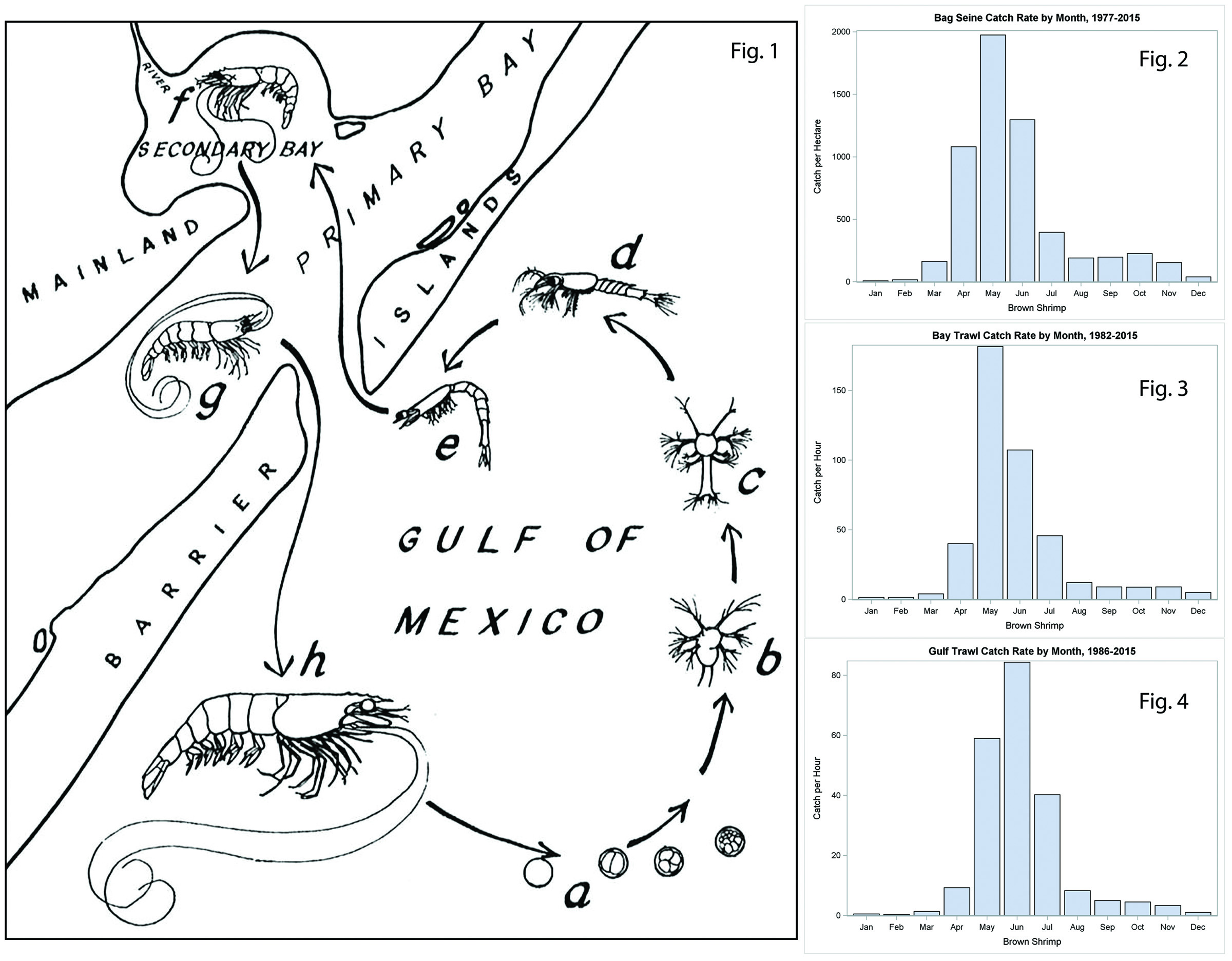Brown Shrimp Life History and Management in Texas

Figure 1: Life history of brown shrimp, Farfantepenaeus aztecus.
a) Shrimp eggs, b) Nauplius larva, c) Protozoea, d) Mysis, e) Postlarva, f) Juvenile shrimp, g) Adolescent shrimp, h) Adult shrimp
Brown shrimp (Farfantepenaeus aztecus) have an annual life cycle and are found in both estuarine and offshore habitats, depending on life stage (Figure 1). Their maximum life span is about 18 months, but few live past 12 months. Adults occur offshore in water depths up to 110 meters (one meter equals 39.4 inches).Spawning can occur year-round but off Texas, peak activity occurs September-November and April-May. Eggs hatch within 24 hours as a nauplius, followed by protozoeal, mysis and postlarval stages. Postlarvae migrate into the estuaries from February to April with incoming tides and develop into juveniles around 25 mm length (one inch equals 25.4mm) and settle in shallow, vegetated or soft muddy areas. Growth is rapid, up to 1 mm/day. Juveniles move into the open bay at 55-60 mm length as subadults then migrate into the Gulf from May to August, coinciding with ebb tides and full moons.
The Coastal Fisheries Division of Texas Parks and Wildlife conducts a fishery-independent resource monitoring program that utilizes a stratified random sampling design to assess changes in the abundance and size of shrimp and organisms, their spatial and temporal distribution, species composition of the community and selected environmental parameters known to influence their distribution and abundance. The program utilizes different sampling gears to target different species and life stages—shrimp are sampled with bag seines (1977-present), bay trawls (1982-present) and Gulf trawls (1986-present). Bag seines are pulled along shorelines and target juveniles; bay trawls are towed in the open bay and target subadults, and Gulf trawls are employed in the nearshore Gulf within 15 nautical miles of each of the five major Gulf passes (Sabine, Galveston, Matagorda, Aransas and Brazos Santiago) offshore to the edge of the Texas Territorial Sea and target adults.
Sampling occurs year-round, with 20 bag seine samples/month/bay (2,160/year coastwide), 20 bay trawls/month/bay (except 10/month in Sabine, East Matagorda, and the upper and lower Laguna Madre; 1,680/year coastwide), and 16 Gulf trawls/month/Gulf area (960/year coastwide). Half of the monthly samples for all three gears are taken in the first half of the month (1st-15th), and the remaining half are taken in the second half of the month to ensure an even temporal distribution.
Bag seine catch rates are an indicator of juvenile brown shrimp abundance.Juveniles are encountered almost year-round, but mostly from April-November with peak abundance in May and a secondary peak in September-October (Figure 2). These peaks in juvenile abundance correspond with the spring and fall spawning activity off Texas. Bag seine-caught shrimp range from 40-75 mm in length.
Bay trawl catch rates are an indicator of subadult abundance in the open bays. Subadults are also encountered almost year-round, but mostly from April-November with peak abundance in May and a secondary peak in September-November (Figure 3). Bag seine catch rates are a good predictor of trawl catches, with bag seines leading trawls by 1-2 biweekly periods. Bay trawl-caught brown shrimp range from 60-105 mm in length. The Texas spring bay shrimp season is open from May 15-July 15.
Gulf trawl catch rates are an indicator of subadult and adult brown shrimp that have emigrated from the bays and are migrating into deeper offshore water.They are most abundant from May-July with a peak in June (Figure 4). Gulf trawl-caught brown shrimp typically range from 85-115 mm in length. Bay trawl catches are a good predictor of Gulf trawl catches, with bay trawls leading by 1-2 biweekly periods. The Gulf brown shrimp season typically opens on July 15.
The annual Texas closure of the Gulf shrimp season serves to protect small brown shrimp from fishing until they reach a larger, more valuable size and to minimize waste from discards of small shrimp during the Gulf harvest. The Texas Parks and Wildlife Code, Chapter 77, Section 77.061(a)(1), 77.065, and 77.067 mandates a closure of the Texas Territorial Sea beginning 30 minutes after sunset on 15 May to 30 minutes after sunset on 15 July; however, these dates can be altered by the Executive Director using sound biological data.
The Gulf closure date is determined from April bag seine catch rates, mean lengths, and dates of maximum ebb tides as a predictor of peak migration. April bag seine catch rates and lengths are used to predict peak abundance and when mean length will reach the target length of 90 mm.
The Gulf opening date is determined from June bag seine catch rates, June bay trawl catch rates and lengths, June Gulf trawl catch rates and lengths, and periods of maximum ebb tides. Growth calculated from June bay and Gulf trawl data is used to predict when shrimp will reach their target size of 112 mm, and to predict peak abundance. Maximum ebb tides are also used to predict major migration periods. Bag seine catch rates are an indication of any late recruits still residing in the bays that will be emigrating later in the season.
These measures, along with other management actions, have ensured the protection of the brown shrimp resource in Texas coastal waters.
Next month Dr. Darin Topping takes a look at some red snapper data.

